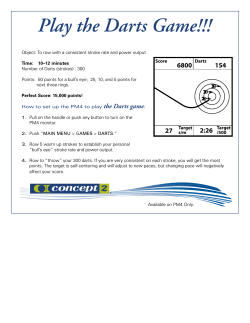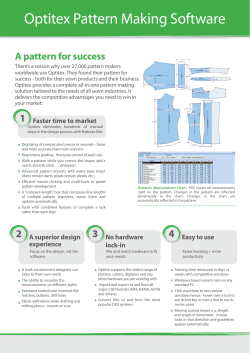
A Brief Look At Pattern Development
A Brief Look At Pattern Development By Sarah Wydville (Sarah Lorraine) © 2002 http://www.modehistorique.com This section applies to both men and women: In the SCA, there are two basic patterns that can be altered to suit the variety of periods we commonly play. Excluding T-Tunics, of course. Some people prefer to draft their own patterns (such as myself) while others feel safer working from commercial pattern. Either way, both methods require a bit of pattern development to first make the garment fit the body it's being made for and secondly, to conform to its designated period. Now, the common mantra is that darts are not period. This is currently debatable as certain evidence from existent garments dating to the 16th century suggest that darts were not a 19th century invention. What is not period however, is the modern placement of darts, especially on women's patterns. On a basic female sloper, there are no less than six darts: Two at the center waist front, one on either side of the breast and two at the center waist back. On men, there are only four darts, two in the front and two in the back. Before you continue, it helps if you have your pattern. If you don't have a pattern to work with, there are a couple of places online that can help you out with drafting one. Getting Rid Of 'Em: Dart Elimination So now that you have your pattern, let's look at ways to adjust it to suit a variety of styles. This is important to know even if you're working with a commercial pattern, because invariably you will need to make adjustments so that the pattern will fit the body you're working with. In other cases, some patterns need to be modified quite a bit before they can be considered workable. One of the most important techniques that no costumer should be without knowlegde of is how to eliminate darts. Calm down. It's not that hard. Eliminating darts is one of those practices that shrouds costuming in an air of mystery. Really, it's not that difficult, provided someone is showing you how it's supposed to be done. So here goes... • Women's Pattern Block • Men's Pattern Block Women's Pattern Block This is the basic female pattern block. No matter what pattern you're working with, it will most likely be derived from this one (with the exception of a T-Tunic). The darts are those triangular pieces that control the shape of the fabric so that it conforms to the shape of the female body. Pretty basic stuff. This is the first step in eliminating the darts. The red lines indicate cutting lines. For the front of the bodice, cut up the center of the waist dart, stopping just short of the bust point (in this case, the little dot). Next, cut up the center of the bust dart (that's the triangle on the side of the pattern) stopping just short of the bust point. For the back of the pattern, measure the width of the back waist dart and mark the same width on the side seam. Draw a straight line from the base of the arm hole to the new measurement. On the front piece, you should have something that looks like a trapezoid hanging on by the bust point. Shift the top edge of the trapezoid until it overlaps the top edge of the original bust dart and tape. Now you have a large triangular gap where the waist dart once was. On the back piece, simply cut along the new line you've just drawn. You're finished for the time being with the back piece. Now, measure the width of the front waist dart, like you did with the back dart. Shift the new measurement to the side edge of the front piece and draw a line from the base of the armhole to the new mark. Cut along this line. Your patterns should look something like this. You can fill in the gap left by the front waist dart by taping a scrap of paper underneath the pattern. This is you basic female block with the darts removed. Now you're ready to modify it for different styles: Basic Elizabethan Elizabethan Doublet / Cotehardie Pattern Cotehardie (Princess Seam) These are some of the more popular styles within the SCA. There really is no limit as to the number of possibilities you can have with this basic pattern. This is just a taste of what is possible, to get you started so that once you're familiar with the basics, you can easily adapt this pattern to suit any of your needs. Male Dart Elimination & Pattern Modification Eliminating darts from a male body block is infinitely easier. On average men have very straight frames, there is no need to work with bust darts. Dart elimination from both front and back patterns is just like removing the darts from the back of the female pattern. To modify the pattern for a Renaissance doublet or cotehardie, the procedure is pretty much the same. Remove the darts from both sides, tape the sides together and then trace, either from the center of the armscye (as shown in this picture) or from the center of the shoulder (as with the woman's cotehardie pattern shown above), a slightly curved line. Your pattern should look like this: And that's it!
© Copyright 2025





















